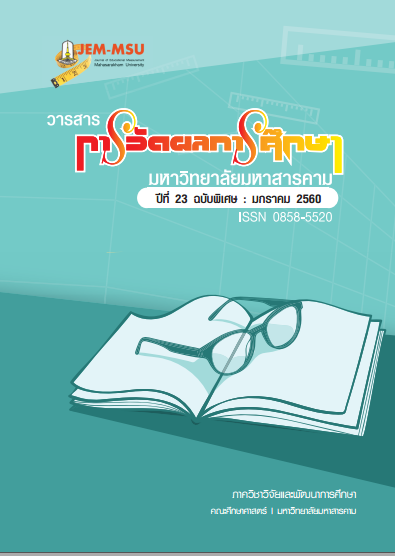The creating a desirable feature of the Grade 6 students in primary school Based on Basic Education Core Curriculum BE 2551
Main Article Content
Abstract
An assessment on the desired characters based on the Basic Education Core
Curriculum B.E. 2551 (A.D. 2008) is an important element of the annual assessment and it
requires effective instruments. In this regard, the objective of this study was to create the
effective assessment form on the desired characters for Prathomsuksa 6 Student. The
population included 5,987 of Prathomsuksa 6 students currently attending class in year 2011
selected from the networking schools under Office of Yasothorn Basic Education
Commission, Yasothorn Province, managing the classroom following the Basic Education Core
Curriculum B.E. 2551 (A.D. 2008). The sample group was 600 students selected from 24
schools by Multi-stage Random Sampling. The research instruments were the Desired
Characters Assessment Form designed as 5-level rating scale and simulated situation covering
4 dimensions and each dimension contains 13 question items. Thus, the assessment form
contains totally 52 question items. These four dimensions included Sincerity, Self-Discipline,
Knowledge Seeking, and Public Mind. The assessment form was tested 3 times; the first and
second testing was completed to find Discrimination of each question item using Mean and
Standard Deviation. The instrument quality was tested with t-test (Independent Samples).
The third testing was conducted to find the Discrimination, Reliability, and Construct Validity
and to create Norms with normalized T-score.
The result found that:
1. The Desired Characters Assessment Form was created as 5-level rating scale and
simulated situation covering 4 dimensions and each dimension contains 13 question items.
Thus, the assessment form contains totally 52 question items. These four dimensions
included Sincerity, Self-Discipline, Knowledge Seeking, and Public Mind.
2. The assessment form contains the following features.
2.1 The Desired Characters Assessment Form contained between 0.89 – 1.00
of Index of Item Objective Congruence.
2.2 In terms of a single dimension, the discrimination of the Desired
Characters Assessment Form suggested that:
2.2.1 In term of Honesty, the discrimination matched every norm
ranging from 11.66 to 26.27.
2.2.2 In term of Self-Discipline, the discrimination matched every
norm ranging from 10.34 to 24.96.
2.2.3 In term of Knowledge Seeking, the discrimination matched
every norm ranging from 5.83 to 17.83.
2.2.4 In term of Public Mind, the discrimination matched every norm
ranging from 2.26 to 15.76.
2.3 The assessment form covering 4 dimensions of the Desired Characters
contains Reliability of 0.74, 0.72, 0.89 and0.72, respectively.
2.4 The construct validity was affirmed by applying Known Group Technique
and tested with T-Test. The assessment form of each dimension contained the lowest score
of construct validity was 32.34 and the highest was 77.89. In total, the assessment form
contained 64.13 of construct validity.
3. The regular score of the assessment form covering 4 dimensions was resulted as
follows; Dimension 1 had regular T score from T30 to T52; Dimension 2 had regular T score
from T38 to T46; Dimension 3 had regular T score from T30 to T80; and Dimension 4 had
regular T score from T25 to T60.
In conclusion, the Desired Characters Assessment Form that the researcher had
designed was affirmed for its effectiveness and applicable to be implemented with the
Prathomsuksa 6 students in order to support the annual desired characters assessment.
Article Details
The content and information contained in the published article in the Journal of Educational Measurement Mahasarakham University represent the opinions and responsibilities of the authors directly. The editorial board of the journal is not necessarily in agreement with or responsible for any of the content.
The articles, data, content, images, etc. that have been published in the Journal of Educational Measurement Mahasarakham University are copyrighted by the journal. If any individual or organization wishes to reproduce or perform any actions involving the entirety or any part of the content, they must obtain written permission from the Journal of Educational Measurement Mahasarakham University.


